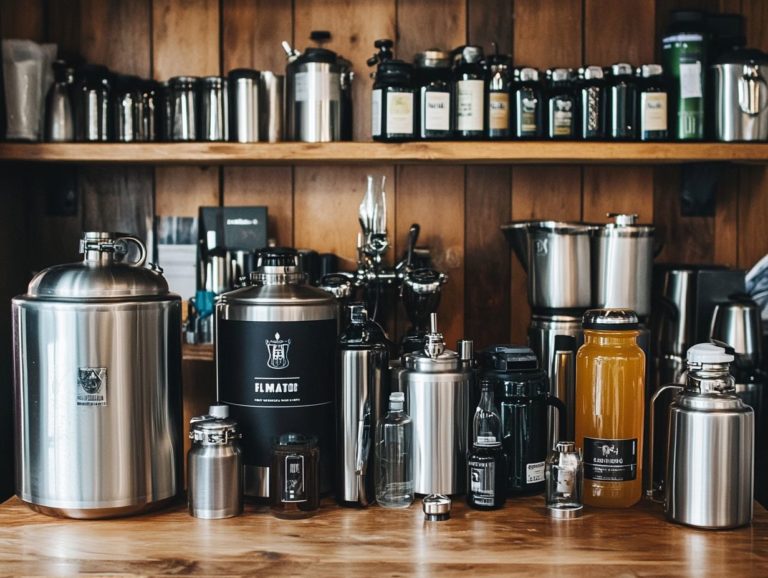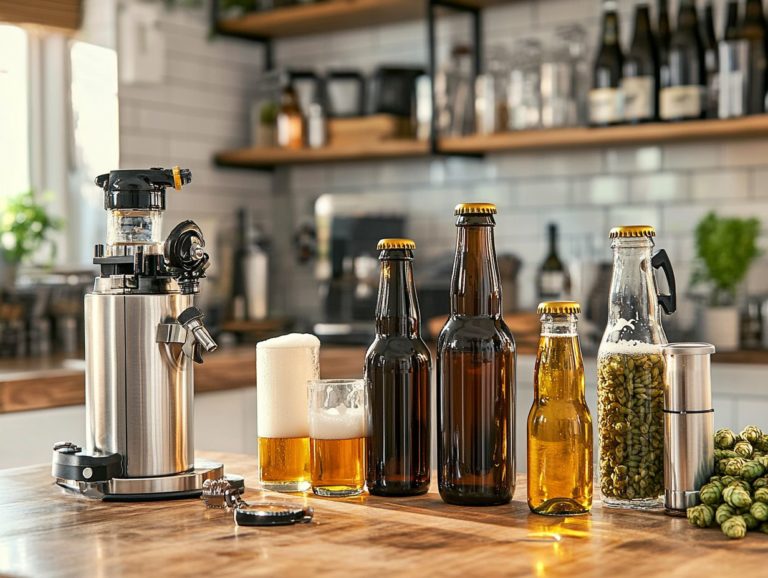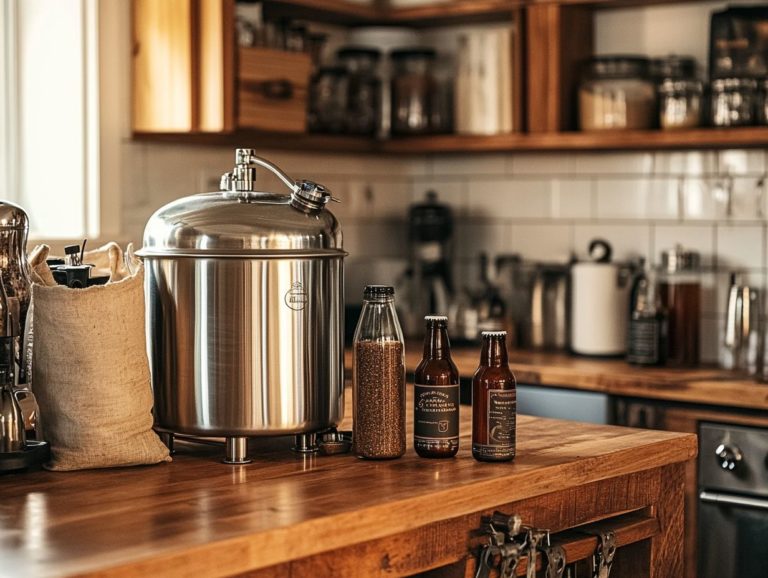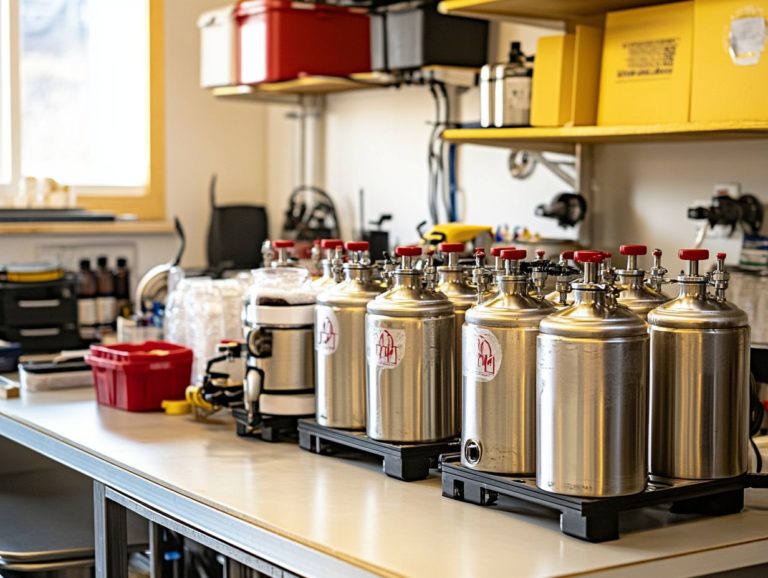Understanding the Role of a Mash Tun
A mash tun stands as a crucial piece of brewing equipment in your brewing process, acting as the heart that transforms grains into the sweet wort essential for crafting your beer. This stage involves critical aspects such as mash tun construction and design.
This article delves into the components of a mash tun, from its vessel design to the false bottom and sparge arm, while emphasizing its primary purpose: converting starches into fermentable sugars through enzyme activation.
You ll discover the various types of mash tuns available, appreciate their benefits, learn about common pitfalls to avoid, and gather tips for enhancing efficiency in your brewing endeavors, such as reducing areas where liquid can get stuck and optimizing mash thickness.
Whether you re just starting out or you ve been brewing for years, grasping the intricacies of a mash tun and understanding its importance in the brewing industry will undoubtedly elevate your brewing experience.
Contents
- Understanding the Mashing Process
- Understanding the Role of a Mash Tun
- 1. Increased Efficiency
- 2. More Control Over the Brewing Process
- 3. Ability to Recirculate Wort
- What Are the Common Mistakes When Using a Mash Tun?
- 1. Not Properly Cleaning and Maintaining the Mash Tun
- 2. Not Controlling Temperature Properly
- 3. Poor Grain Crush
- How Can You Improve Your Mash Tun Efficiency?
- What is a mash tun and what is its role in the beer brewing process?
- How does a mash tun work?
- Why is it important to understand the role of a mash tun in brewing beer?
- What are the different types of mash tuns?
- How does the size of a mash tun affect the brewing process?
- Are there any alternative methods to using a mash tun in brewing?
Key Takeaways:
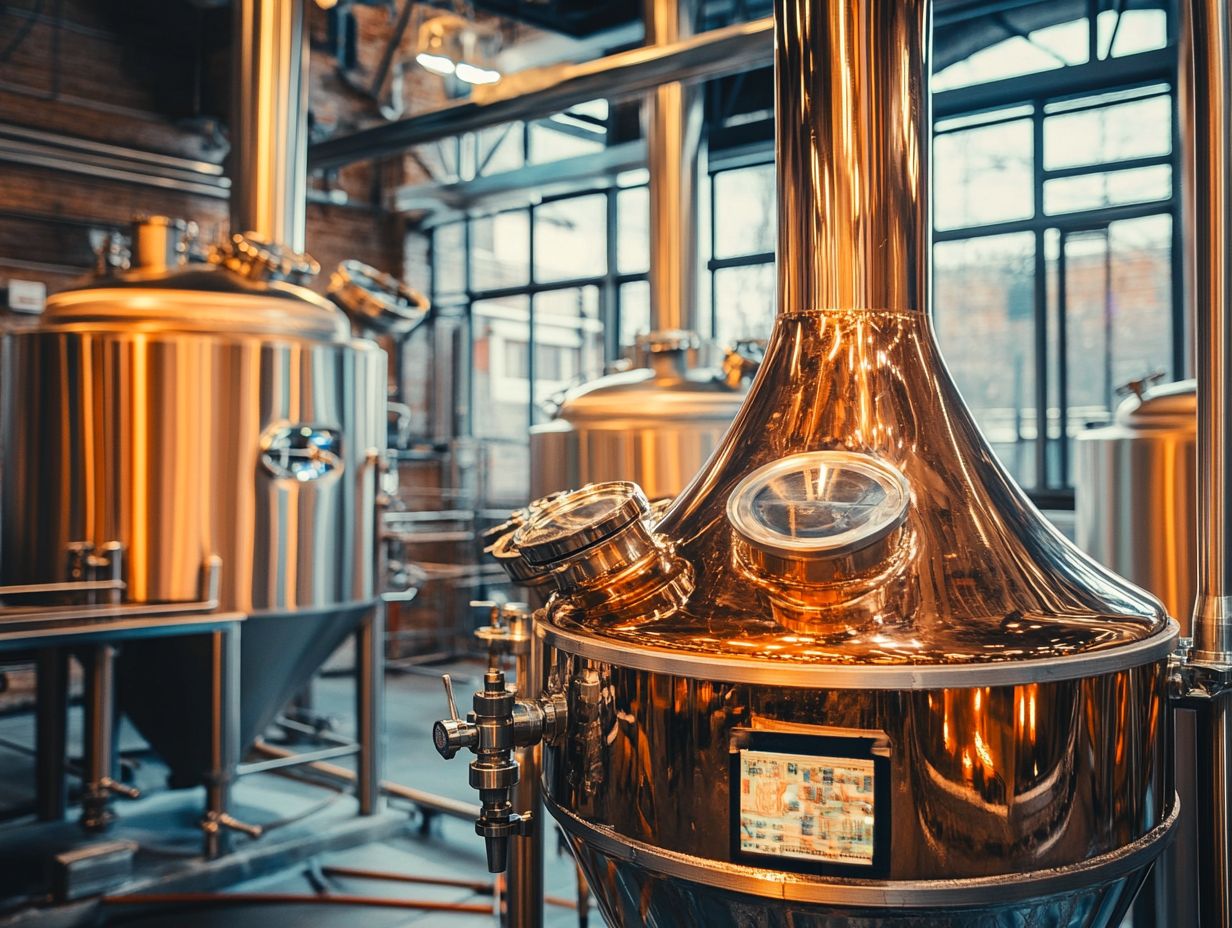
- A mash tun is a vessel used in the brewing process to convert starches into fermentable sugars and extract sugars from grains.
- There are various types of mash tuns available, including traditional, insulated, and electric options, each contributing differently to brewing efficiency and wort extraction.
- Using a mash tun can lead to increased efficiency, control over the brewing process, and the ability to recirculate wort, which is essential in both traditional breweries and microbreweries.
What Is a Mash Tun?
A mash tun is an essential piece of brewing equipment that transforms starches from malted grains into fermentable sugars during the mashing process. This vital tool is key for both craft and large-scale breweries, as it serves as the vessel where mash thickness is meticulously controlled and enzyme activation takes place, yielding a sweet liquid known as wort. Companies like Br u Supply and Tiantai specialize in providing high-quality mash tuns for brewing operations.
The design and quality of the mash tun significantly influence brewing efficiency and flavor profiles. This makes it critical not only for everyday brewing operations but also for advancements in the brewing industry, including the development of brewing technology and innovations.
1. Mash Tun Vessel
The mash tun vessel is an essential element of your brewing setup, meticulously designed to enhance the mashing process by creating an ideal environment for optimal heat distribution and enzyme activation.
Constructed from robust materials such as stainless steel or copper, this vessel is crafted to endure the temperature fluctuations and pressures that arise during mashing. This durability is essential for both homebrewers and professionals in the brewing community.
Its design typically features a false bottom, which reduces areas where liquid can get stuck, ultimately hindering your brewing efficiency.
The added insulation plays a crucial role in maintaining consistent heat levels, ensuring that enzymes remain active throughout the mashing process. This translates to a more effective conversion of starches into fermentable sugars, which is particularly important for brewing performance and achieving high brewing quality.
As you consider your brewing journey, take into account the shape and size of the mash tun. These characteristics significantly impact the flow dynamics of the wort, leading to an overall enhancement in the brewing process. Effective mash tun utilization can also help reduce brewing costs and improve mash tun efficiency.
Explore different types of mash tuns or experiment with your own brewing process to elevate your brewing experience!
2. False Bottom
The false bottom in a mash tun is an essential element. It helps separate the grain bed from the wort during lautering and sparging, ensuring effective wort runoff.
This design boosts the efficiency of wort extraction and optimizes brewing techniques. It provides a stable platform for the grain bed, enhancing flow rates while minimizing uneven flow.
This component allows for better rinsing of sugars from the grains. As a result, you attain a more consistent product with precise control over fermentation parameters.
Incorporating a false bottom can elevate your brewing process. It directly influences the final flavor profile of your beer. Proper maintenance is crucial for long-term performance.
3. Sparge Arm
A sparge arm is a critical part of your mash tun. It distributes water evenly over the grain bed during the sparging process, which is vital for achieving high gravity wort.
This device optimizes wort extraction and enhances the overall efficiency of your brewing endeavors. The sparge arm moves across the grain surface, ensuring that water washes out the maximum amount of fermentable sugars.
Achieving a thorough rinsing of the grain bed maximizes extraction efficiency. By consistently delivering water at a controlled rate, the sparge arm maintains balance, preventing uneven soaking that could compromise quality.
When used correctly, this device is key in producing high gravity wort, essential for crafting flavorful and robust beers.
4. Thermometer
Your mash tun s thermometer is your best friend in brewing! It helps you monitor and control the mash temperature, which directly influences the quality of your brew and the activation of important enzymes.
Maintaining precise temperature control optimizes the extraction of fermentable sugars from your malted grains. Different temperature ranges activate specific enzymes, like amylase, essential for breaking down starches into sugars necessary for fermentation.
If temperatures stray too far from the sweet spot, you risk incomplete conversion, lowering alcohol yield and affecting your beer’s overall flavor profile.
Therefore, careful attention to temperature enhances sugar extraction and is vital for achieving the desired characteristics of your final brew. This highlights the importance of meticulous monitoring during this essential phase of brewing.
What Is the Purpose of a Mash Tun?
The mash tun serves a crucial purpose in your brewing process: it facilitates the mashing process. Here, starches from malted grains transform into fermentable sugars, essential for creating wort.
This wort is then fermented into beer, making the mash tun a key player in your brewing operations and overall efficiency. Proper cleaning is also necessary to maintain brewing quality and ensure optimal utilization.
Understanding the Mashing Process
1. Converting Starches to Sugars
Converting starches to sugars is the primary purpose of the mashing process in the mash tun, where enzymes expertly break down complex carbohydrates into the fermentable sugars essential for fermentation.
As you navigate this intricate process, specific enzymes such as alpha-amylase and beta-amylase take center stage. Alpha-amylase kicks things off by breaking down starch molecules into shorter chains called dextrins, while beta-amylase steps in to further cleave these dextrins into maltotriose and glucose.
These biochemical reactions are crucial, as they directly shape the sugar profile available for fermentation. Well-executed mash tun optimization can significantly enhance brewing yield and the final beer s quality. This, in turn, affects not just the efficiency of your brewing process but also the overall flavor and quality of the final beer.
A meticulously executed mashing process ensures optimal enzyme activity, leading to a higher yield of fermentable sugars, ultimately enhancing the character and complexity of your brewed beverage.
2. Extracting Sugars from Grains
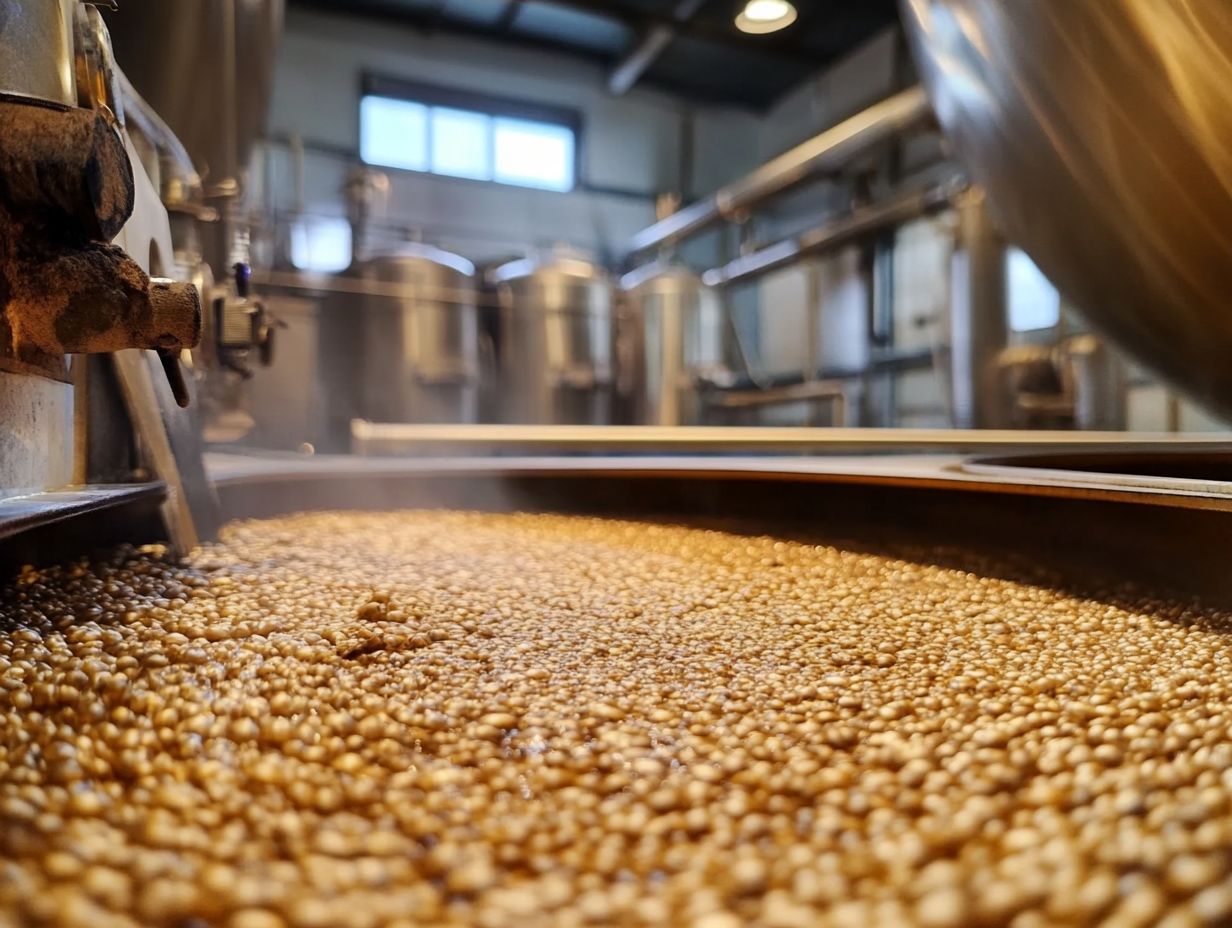
Extracting sugars from grains is a pivotal step after mashing. You separate the wort from the grain bed, influencing brewing efficiency and beer quality.
The extraction process is critical, as it uses methods like lautering and sparging to maximize your sugar yield. Lautering is the process of draining the liquid wort, while sparging is washing the grain with hot water to extract remaining sugars.
The meticulous execution of these methods enhances your extraction efficiency and impacts the flavor profile of your finished beer. Utilizing advanced brewing technology can further improve the process and brewing innovations. This makes them essential components of your modern brewing toolkit.
3. Controlling Temperature
Controlling the mash tun temperature is crucial during the mashing process, as it directly influences enzyme activity and the production of fermentable sugars, impacting both the quality and efficiency of your brew.
To maintain an optimal temperature range typically between 150 F and 158 F you ll enable specific enzymes to flourish. Companies like Br u Supply provide advanced brewing supplies to help maintain these conditions.
For instance, alpha-amylase performs its magic at the higher end of this spectrum, breaking down starches into sugars for fermentation, while beta-amylase shines at slightly lower temperatures, skillfully releasing maltose. These delicate balances are essential, as even slight variations can lead to under or over-extraction, which in turn affects the final flavor profile and alcohol content of your brew.
By grasping the importance of temperature control, you not only enhance enzyme performance but also elevate the entire brewing process ensuring that your final product meets the highest quality standards and satisfies consumer expectations.
What Types of Mash Tuns Are Available?
You ll find a range of mash tuns in the brewing industry, from traditional styles to insulated and electric options. Each type comes with unique mash tun features and benefits, aiding in brewing advancements.
Each type comes with its own distinct advantages, showcasing the latest advancements in brewing equipment. Whether you prefer the classic approach or a more modern solution, there’s a mash tun that perfectly aligns with your brewing ambitions and brewing operations.
Investing in the right mash tun can elevate your brewing experience don t settle for less!
Traditional Mash Tuns
Traditional mash tuns have been the backbone of the brewing process for centuries, exemplifying skilled craftsmanship. They offer a dependable means to convert starches into fermentable sugars and enhance brewing efficiency. These vessels are pivotal in the mashing process of traditional breweries.
Typically crafted from thick copper, stainless steel, or even wood, these vessels play a crucial role in shaping not only the temperature but also the overall character of your beer. The choice of material significantly impacts heat retention and distribution, which is vital for achieving optimal conditions for converting starches into sugars.
For example, copper boasts exceptional thermal conductivity, helping you maintain that perfect mash temperature. Meanwhile, stainless steel stands out for its durability and ease of cleaning, elevating hygiene standards.
The thoughtful design and construction of these traditional mash tuns are essential for cultivating rich flavors and aromas, ultimately influencing the quality of your final brew.
Insulated Mash Tuns
Insulated mash tuns are crafted specifically to maintain a consistent temperature during the mashing process. This enhances temperature retention and creates optimal conditions for enzyme activity and brew quality.
By effectively minimizing heat loss, these vessels cultivate an ideal environment where essential enzymes can flourish. This leads to superior sugar extraction from the grains and results in improved wort extraction and mash tun efficiency.
This thoughtful design conserves energy and boosts overall efficiency by reducing the need for frequent temperature adjustments. The materials used often feature thick insulation layers that protect against ambient temperature fluctuations, giving you greater control over your recipes and brewing costs.
As a result, the consistency achieved with insulated mash tuns can elevate your final product. You’ll yield brews with enhanced flavors and aromas that satisfy the demands of both artisanal and commercial brewing.
Electric Mash Tuns
Electric mash tuns harness modern brewing equipment to give you precise control and automation over the mashing process. This significantly boosts your brewing efficiency and ensures consistency in the final product, showcasing advancements in the brewing industry.
With advanced features like programmable temperature settings and automatic stirring mechanisms, these systems empower you to create optimal conditions for enzymatic activity, which means the processes that convert starches into sugars. This level of control not only reduces the risk of human error but also facilitates repeatability in your recipes, essential when scaling up production in both artisanal and commercial brewing practices.
The energy efficiency of electric systems often means lower operating costs over time. The convenience of remote monitoring through smart applications enhances their appeal, allowing you to focus on perfecting your craft while ensuring that each batch meets your high standards.
What Are the Benefits of Using a Mash Tun?
Utilizing a mash tun provides you with a multitude of advantages, including enhanced brewing efficiency, optimized wort extraction, and superior brew quality. This essential tool can transform your brewing experience!
Efficient mash tun utilization directly impacts brewing yield and overall brewing performance. Embrace the power of a mash tun and elevate your brewing game!
Understanding the Role of a Mash Tun
1. Increased Efficiency
Increased efficiency is one of the key benefits you’ll enjoy from using a mash tun! It allows you to optimize the mashing process and maximize the extraction of those all-important fermentable sugars. Effective mash tun utilization reduces dead space and improves mash efficiency.
This streamlined approach accelerates your production timelines while ensuring a more consistent grain-to-sugar conversion rate, making your brewing experience smoother. With enhanced temperature control and uniformity during mashing, a mash tun elevates the flavor profile and aroma of your final product, resulting in a beer that truly stands out. Therefore, mash tun utilization plays a crucial role in achieving a superior beverage.
With this specialized equipment at your disposal, you greatly reduce the risk of starches remaining unconverted, which can significantly impact the quality of your brew. Integrating a mash tun into your brewing operations is essential; it strikes the perfect balance between efficiency and the artisanal elements of brewing, ultimately leading to a superior beverage that exceeds consumer expectations.
2. More Control Over the Brewing Process
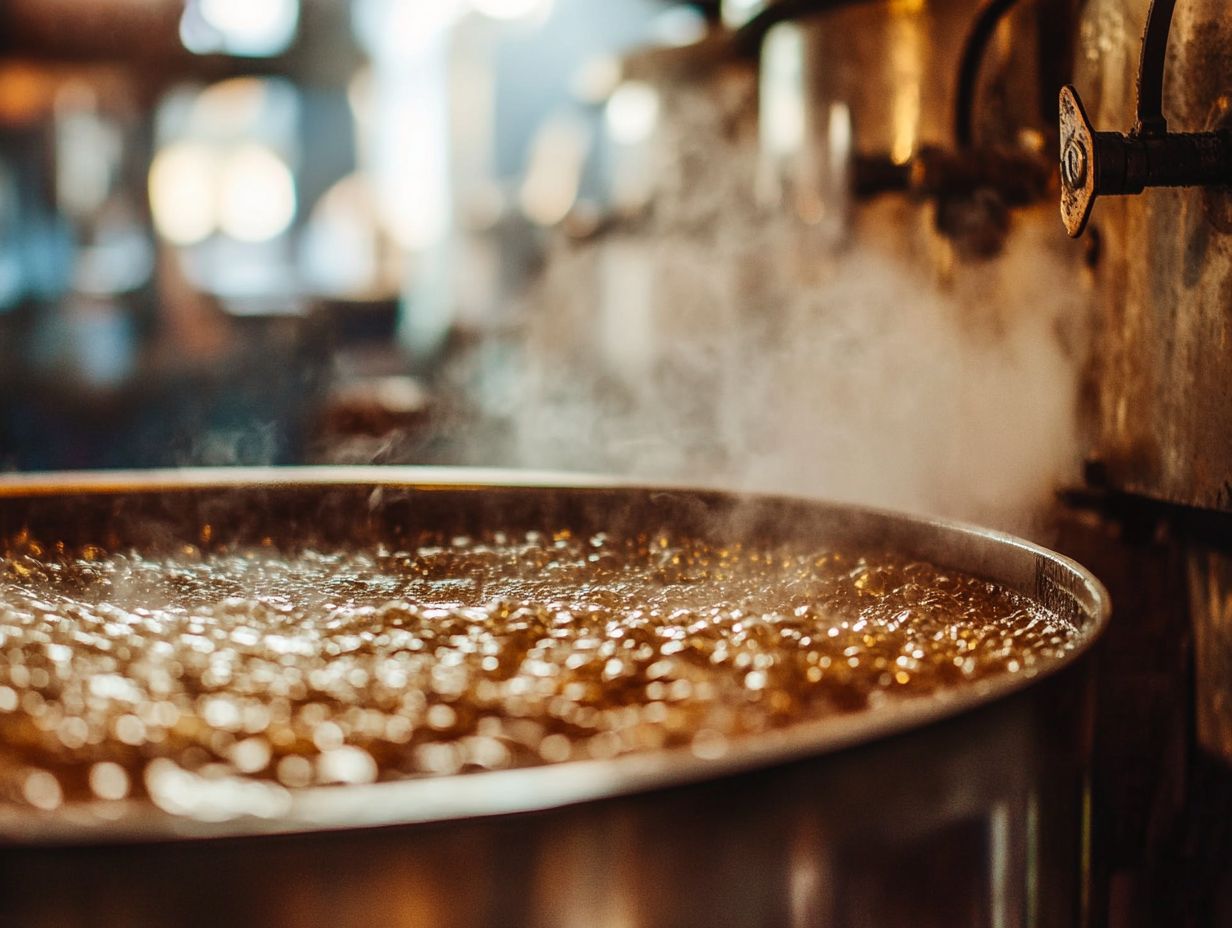
You gain amazing control with a mash tun, especially regarding mash tun temperature! This allows for precise adjustments that can profoundly influence the final beer’s flavor and quality. Effective mash tun optimization can significantly impact brewing quality.
This specialized vessel gives you the power to modify not just the temperature but also the timing, which is also critical during the mashing process. By carefully managing the temperature within the mash tun, you can adjust the enzymatic activity, or the process where enzymes break down starches into sugar. For example, a lower temperature might encourage lighter, more delicate flavors, while a higher temperature can produce a fuller-bodied beer with richer characteristics. This type of control is crucial for microbreweries looking to perfect their brew.
With the ability to fine-tune the mash duration, you can dictate the depth of flavor and aroma profiles, ensuring that the final product meets your exact specifications. This level of control underscores the mash tun’s vital role in crafting a unique beer experience that reflects your vision and highlights the importance of brewing techniques in achieving high-quality results.
3. Ability to Recirculate Wort
The ability to recirculate wort during the mashing process presents a remarkable advantage for you when using a mash tun! It enhances the extraction of fermentable sugars and significantly improves your overall brewing efficiency. This technique ensures superior wort runoff.
This method gives you the power to keep your mash at the perfect temperature, ensuring that enzymatic activity is optimized for the best possible results. As you draw off and return the wort to the top of the mash bed, you achieve a clearer wort by filtering out grain solids and maximizing the flavor compounds present in the grains. This process is crucial for effective mash tun optimization.
Breweries that embrace wort recirculation often find an elevation in the complexity of flavors within the final product, alongside a reduction in brewing time, enabling quicker turnaround on batches. By investing in this method, you cultivate a more consistent and quality-focused brewing process, ultimately leading to a rewarding experience for both you and your consumers. This technique is highly regarded in both the microbrewery and broader brewing community.
What Are the Common Mistakes When Using a Mash Tun?
Common mistakes when using a mash tun can greatly impact your brewing process. Inadequate cleaning of the mash tun, neglecting to maintain the proper temperature, and a poor grain crush can all lead to diminished brewing efficiency and less-than-optimal beer quality. These issues can be mitigated with proper brewing techniques and regular mash tun maintenance.
It s essential to pay attention to these details to ensure your brewing experience yields the best results.
1. Not Properly Cleaning and Maintaining the Mash Tun
Neglecting to properly clean and maintain the mash tun can lead to contamination and off-flavors in your final product, undermining both the quality of your brew and the effectiveness of your brewing practices. This essential part of the brewing process demands your regular attention to preserve the integrity of your ingredients and the overall flavor profile of your beer.
Utilizing the right brewing supplies for mash tun cleaning is crucial. Establish a systematic cleaning schedule after each use, employing the right tools such as brushes, pressure washers, and food-safe cleaning agents specifically designed for brewing equipment. Keeping an eye on temperature and pH levels during the cleaning process is vital for achieving thorough sanitation.
Conducting routine maintenance checks will help you spot any wear and tear that could compromise your brewing efficiency. By doing so, you ensure that every batch meets your desired standards and remains free from any unwanted microbial influences. Regular mash tun maintenance is key to success for optimal brewing performance.
2. Not Controlling Temperature Properly
Failing to maintain proper control over mash tun temperature can significantly hinder enzyme activity and reduce the extraction of fermentable sugars, ultimately compromising brewing efficiency and the fermentation process as a whole. This impacts overall brewing quality and yields.
When mashing temperatures stray from the optimal range, critical enzymes may become inactive or work inefficiently. This inefficiency can lead to inadequate conversion of starches into sugars, resulting in an imbalanced wort that lacks the essential components for robust fermentation.
As a result, you might find yourself facing a lower alcohol content in the final product and a diminished flavor profile, which can be less enticing for consumers. Furthermore, temperature fluctuations can introduce undesirable flavors and aromas, further detracting from the brew’s quality. Effective use of brewing technology can help mitigate these issues.
Meticulous temperature monitoring during mashing becomes critical, not just for achieving successful fermentation but for crafting a high-quality beer that aligns with market expectations.
3. Poor Grain Crush
A poor grain crush can significantly impede the efficiency of your mash tun, resulting in inadequate wort extraction and an overall less effective brewing process. Proper grain bed management is crucial to avoid dead space and improve mash tun performance.
When your grains aren t crushed properly, you re left with large particles that hinder optimal enzyme activity during the mashing process. This improper breakdown reduces the surface area exposed to water, which in turn inhibits the conversion of starches into precious fermentable sugars.
As a result, you may find yourself staring at a lower gravity reading than anticipated, which ultimately influences the flavor profile and overall alcohol content of your final product. Striving for the perfect grain crush ensures better contact between the grains and water, enhancing the extraction of sugars and maximizing your brewing efficiency. This process is especially critical in traditional breweries and microbreweries where consistent quality is key.
This attention to detail is crucial for crafting high-quality beers that stand out. Additionally, using high-quality brewing supplies is essential for maintaining consistency and excellence in your brewing operations.
How Can You Improve Your Mash Tun Efficiency?
Improving mash tun efficiency is a cornerstone of enhancing overall brewing operations and brewing quality. Enhancing your mash tun efficiency requires the application of essential brewing techniques.
Focus on proper grain crushing to optimize wort extraction, diligently monitor and control the mash tun temperature, and maximize wort recirculation. By doing so, you can significantly elevate the overall quality of your brewing process.
Considering mash tun design and construction can also play a vital role in achieving higher mash tun efficiency and brewing performance.
1. Properly Crush Your Grains
Crushing your grains properly is crucial for enhancing the efficiency of the mash tun. It creates a uniform grain bed that allows for optimal water penetration and extraction during the brewing process. Achieving a consistent particle size helps prevent issues with dead space during lautering.
This crushing process maximizes the surface area of your grains and boosts enzyme activity, which is essential for effective starch conversion. Techniques like adjusting the roller gap on your mill can help you achieve the perfect consistency, whether you prefer a coarse or fine crush. Properly crushed grains also enhance mash thickness, crucial for efficient wort extraction.
Different types of brewing equipment, such as two-roller or three-roller mills, employ various crushing mechanisms. Choosing the right mill ensures a consistent particle size, minimizing the risk of creating flour-like particles that could impede flow during lautering. Ensuring an optimal crush also aids in better heat distribution during the mashing process.
Striking this delicate balance ultimately leads to higher extraction rates, improved brewing efficiency, and superior quality in your final brew.
2. Monitor and Control Temperature
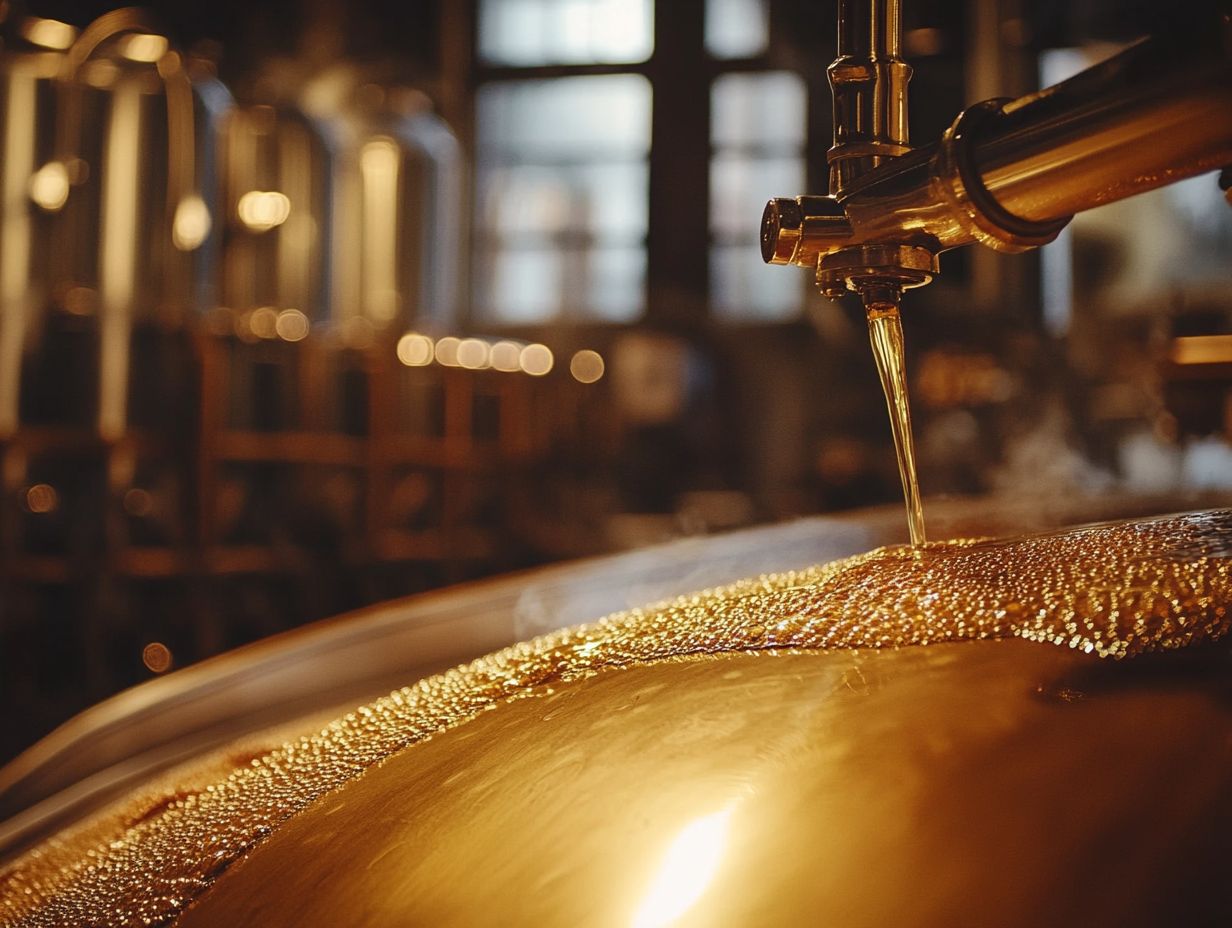
Monitoring and controlling the temperature of your mash tun throughout the mashing process is essential for maximizing enzyme activity and extracting fermentable sugars. Both of these factors directly impact your brewing practices and the quality of your beer.
When you achieve the right temperature, you’re not just optimizing the enzymatic reactions that break down starches you’re also enhancing the overall flavor profile of your brew. Properly setting up your temperature control devices, such as thermoregulators and heat exchangers, is crucial for maintaining the thermal stability you need.
By ensuring that your mash stays within specified temperature ranges, you can dramatically improve fermentation efficiency. This careful attention ensures you ll craft higher-quality brews that impress every time! Effective temperature control also reduces brewing costs by preventing potential issues during fermentation. Ultimately, this sets the stage for exceptional brewing outcomes that you can take pride in.
3. Recirculate Wort
Recirculating wort during the mashing process elevates the clarity of the grain bed and enhances extraction efficiency. This ultimately contributes to a higher overall brewing efficiency and quality of your final product. Effective recirculation techniques are essential in modern brewing operations.
This method allows for a more uniform temperature distribution and ensures that the sugars and flavors are fully extracted from the malted grains. By continually drawing off and reinjecting the wort, you can maintain optimal conditions within the Mash Tun, aiding in achieving your desired specific gravity and resulting in a cleaner, crisper beer.
Proper management of wort runoff during this process is also important to achieve optimal results. Wort recirculation minimizes unwanted compounds that could introduce off-flavors, thereby enhancing the complexity and profile of your brew. This meticulous approach can significantly influence the final outcomes, making it a cherished technique among seasoned brewers.
Regular cleaning and maintenance of the mash tun prevents the buildup of unwanted compounds.
Frequently Asked Questions
Here, we answer some common queries that brewers in the brewing community often have.
What is a mash tun and what is its role in the beer brewing process?
A mash tun plays a vital role in the brewing process. It is essential for traditional breweries and microbreweries alike.
A mash tun is a vessel used to convert grain starches into sugars that can be fermented to make alcohol. It plays a crucial role in creating the wort, the liquid that is fermented to produce beer. Typically, mash tun components include stainless steel construction for durability and ease of cleaning.
How does a mash tun work?
A mash tun works by mixing crushed grains with hot water to create a mash. This mixture is then allowed to rest for a period of time. During this rest, enzymes in the grains break down the starches into simpler sugars, resulting in a sugary liquid known as wort.
Why is it important to understand the role of a mash tun in brewing beer?
Understanding the role of a mash tun is key to mastering the art of brewing delicious beer! It allows brewers to control the brewing process and produce consistent, high-quality beer. This knowledge also helps brewers troubleshoot any issues that may arise, enhancing the overall quality of their brews.
What are the different types of mash tuns?
There are several types of mash tuns, including infusion mash tuns, decoction mash tuns, and combination mash/lauter tuns. The type of mash tun used depends on the brewing process and desired results. Additionally, advancements in brewing have led to new mash tun variations that offer greater efficiency and control.
How does the size of a mash tun affect the brewing process?
The size of a mash tun can affect the brewing process in several ways. A larger mash tun allows for a higher volume of grains and water, which can result in a higher alcohol by volume (ABV) beer. A smaller mash tun may be better for experimental or specialty brews. Optimizing your mash tun can significantly boost your brewing yield and enhance your beer’s flavors.
Are there any alternative methods to using a mash tun in brewing?
Yes, some brewers may use a process called “brew-in-a-bag” (BIAB) as an alternative to using a mash tun. This method involves using a mesh bag to steep the grains in hot water, eliminating the need for a separate mash tun. However, traditional mash tuns remain widely favored for their versatility in various brewing practices.

